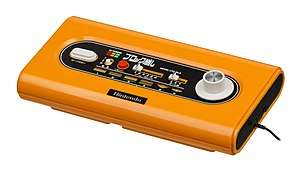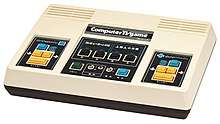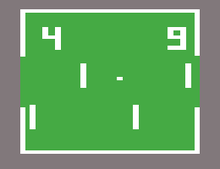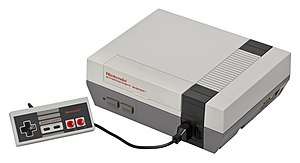Color TV-Game
The Color TV-Game[lower-alpha 1] series of five dedicated home video game consoles was created by Nintendo and released in Japan only. Nintendo sold three million units of the first four models: one million units of each of the first two models, Color TV-Game 6 and 15; and half a million units of each of the next two models, Block Breaker and Racing 112. The Color TV-Game series has the highest sales figures of all the first generation of video game consoles. The systems can run on C batteries or an AC adapter. It is also the first console to be released by Nintendo.
 A Color TV-Game Block Kuzushi | |
| Developer | Nintendo R&D2 Mitsubishi Electronics |
|---|---|
| Manufacturer | Nintendo |
| Type | Dedicated home video game consoles |
| Generation | First generation |
| Release date | June 1, 1977 |
| Lifespan | 1977–1983[1] |
| Discontinued | 1983 |
| Units sold | 3 million[2] |
| Successor | Family Computer Nintendo Entertainment System |
History
.jpg) Color TV-Game 6 |
.jpg) Color TV-Game 15 |
 Color TV-Game Racing 112 |
 Computer TV-Game |
By the late 1970s, Nintendo began moving away from toys and playing cards and into the rapidly-growing video game market. Their decision was based on the release of the hugely-successful arcade game Space Invaders by Taito and the 1973 oil crisis making toys expensive to produce.[3] Nintendo's first foray into the industry was Computer Othello in 1975.[4] They followed it with games such as Sheriff, Space Fever, and EVR-Race. Most of these were unsuccessful but made Nintendo view video games as the next market to jump into.[5] The home console market also saw a rise in popularity, particularly in North America with the release of Atari's Pong system in 1975.[6] This caused the market to become flooded with similar "video tennis" games as companies scrambled to cash in on its success. Nintendo was no exception, and decided to make their own dedicated Pong system as a way to bring its popularity over to Japan.[6]
The Color TV-Game consoles were produced jointly by Nintendo Research & Development 2 (R&D2) and Mitsubishi Electronics.[7][8] Nintendo had no prior knowledge of manufacturing electronics, so they enlisted the help of Mitsubishi to mass-produce them. Mitsubishi previously assisted Nintendo in production of EVR Race, which provided a good relationship between the two companies.[9] For the first two consoles, Color TV-Game 6 and Color TV-Game 15, Nintendo acquired a license from Magnavox that allowed them to produce their own Pong-esque game consoles. Magnavox created the original concept for Pong for their Magnavox Odyssey console, which inspired Atari to create a similar game for arcades.[10] This angered Magnavox founder Ralph H. Baer, who sued Atari for infringing on their rights.[11] Nintendo president Hiroshi Yamauchi specified that the consoles had to be produced quickly and with cheaper parts to lower production costs. He wanted the systems to be cheap for the consumer to purchase to give them an edge over their rivals.[12] The TV-Game 6 and 15 required little production time due to their simplicity. Mitsubishi made minor changes and corrections to the systems before they were released.[9]
The Color TV-Game 6 launched on June 1, 1977.[1][13] It retailed at a price of ¥9,800, which was significantly lower than competing systems. Nintendo used this as a marketing tool.[6] As its title implies, it contains six variations of Pong, such as adding additional paddles, decreasing the size of the paddles, and adding deflective shields in the center of the screen. It could be powered by batteries or by a power adapter that was sold separately. Shortly after its release, Nintendo released an improved version of the TV-Game 6, featuring a cream-white outer casing and removing the power adapter.[6] A second variation was produced as part of a promotion with food company House Foods to promote their House Shanmen instant noodles. It is identical to the original TV-Game 6 but has the House Shanmen logo on the casing. This version was produced in very limited quantities, making it extremely rare.[6] Sharp Electronics produced dark orange-colored versions of the TV-Game 6 to bundle with their television sets.[6]

A week later on June 8, Nintendo released the Color TV-Game 15.[14] It retailed for ¥15,000, roughly 50% more than the TV-Game 6. In a sense, the TV-Game 15 was a re-release of the TV Game 6; the latter had fifteen games, but only six were playable out of the box.[15] The TV-Game 15 has detachable controllers which are stored in a small compartment on the system. Nintendo produced a second model of the TV-Game 15 with a reddish-orange casing, which had a longer production run and as such are more common than the orange version.[15] Sharp made a white-colored version that was renamed Color TV-Game XG-115.[15]
The third unit, the Color TV Game Racing 112, was published on June 8, 1978. It is significantly larger than the previous two units, with a larger shipping box to accompany it. Racing 112 was set to be released at ¥18,000, but was lowered to ¥12,000 to ensure competitiveness.[16] It was later reduced to ¥5,000. To prevent the machine from requiring a larger box, the wheel is detachable from the console.[16] The built-in game is a top-down racer similar to Speed Race, an arcade game released by Taito in 1974.[16] Variations include a smaller screen width and opponents that move faster, with all possible game combinations totaling to 112. The console also comes with two paddle controllers that allow for multiplayer.[16] It was followed by the Color TV Game Block Kuzushi, released at ¥13,500 on April 23, 1979. The system was produced in-house by Nintendo, allowing their name to be prominently displayed.[17] Block Kuzushi includes six variations of Breakout, an arcade game released in America by Atari. Nintendo themselves released a clone of Breakout titled Block Fever for Japanese arcades in 1978.[18] Rival company Epoch released the TV Block console in Japan, which was successful and gave way to steady competition by other companies, including Nintendo.[12][17] The system's casing was designed by Mario creator Shigeru Miyamoto. It is one of his first video game projects after joining Nintendo in 1977.[17] The built-in games for Racing 112 and Block Kuzushi were designed by Takehiro Izushi.[19] Nintendo held competitions in department stores to promote the Block Kuzushi, where winners received a congratulatory note and a medal.[17]
The final console, the Computer TV Game, was released in 1980. As dedicated consoles were decreasing in popularity, the Computer TV Game was only produced in limited quantities, making it extremely rare.[20] Miyamoto again designed the system's white-colored casing as well as the packaging.[20] It was produced in house as well with no help from outside companies. Computer TV-Game contains a port of Computer Othello, and is built right around an original Computer Othello arcade system board.[21] This makes it an arcade-perfect rendition, an uncommon sight during the early 1980's.[20] The entire Color TV-Game series was discontinued in favor of the Family Computer in 1983, a cartridge-based system that could play hundreds of games.[20] The Famicom, and its international counterpart the Nintendo Entertainment System, sold millions[22] and solidified Nintendo's presence in the video game hardware market.[20]
Legacy

The Color TV-Game series was very successful for Nintendo, and was a commercial hit. The Color TV-Game 6 and Color TV-Game 15 sold one million units each. Racing 112 and Block Kuzushi sold half a million units each.[2] Their success prompted Nintendo to continue pursuing the video game console market, which inevitably lead to the creation of the Family Computer and the Nintendo Entertainment System. Publications have recognized it as being Nintendo's first video game consoles. Erik Voskuil, writing for his blog Before Mario, believes that part of the reason the Color TV-Game series was successful was for its low price point, far cheaper than the competition.[6] He wrote that: "Almost thirty-five years and multiple generations of ever improving, multi-million selling Nintendo video game consoles on, we can reflect on this moment as the beginning of something very, very big."[6] In his 2004 book Power-Up: How Japanese Video Games Gave the World an Extra Life, Chris Kohler claims that the colorful casing played a part in the systems performing well, saying they resembled toys more than video game consoles.[23] Luke Plunkett of Kotaku acknowledged the consoles for their importance as Nintendo's first foray into the market, and for it being influential for their next system. Plunkett agreed with Voskuil in the series being successful for their low price, as it established Nintendo's "consoles must be sold at a profit" attitude that continues today.[24] PC Magazine's Benj Edwards that the Color TV-Game 6 and Color TV-Game 15 units in particular gave Nintendo faith in the market due to their commercial success. He also noted that the Block Kuzushi marked the debut of Shigeru Miyamoto, an important figure within the company.[25]
Nintendo has referenced the Color TV-Game systems and their built-in games in other franchises. Alleyway, a launch title for the Game Boy, is believed to be based on the Color TV-Game Block Kuzushi.[26] Journalist Jeremy Parish went as far to say that Alleyway is a throwback to Block Kuzushi, due to it having been cemented in Nintendo's corporate roots.[26] WarioWare, Inc.: Mega Microgames! includes a minigame based on Racing 112, where the player has five seconds to dodge the moving cars.[27] It is part of 9-Volt's stage, which comprises minigames featuring older Nintendo video games. A Color TV-Game 6 minigame appears in 9-Volt and 18-Volt's stage in WarioWare: Smooth Moves.[12] An assist trophy based on the TV-Game 15 appears in Super Smash Bros. for Nintendo 3DS and Wii U and its follow-up Super Smash Bros. Ultimate.[28] When summoned, it spawns a pair of paddles that launch a ball across the level, which will inflict damage on fighters that touch it.
Notes
References
- DeMaria, Rusel; Wilson, Johnny L. (2003). High Score!: The Illustrated History of Electronic Games (2 ed.). McGraw-Hill. pp. 363, 378. ISBN 978-0-07-223172-4.
- Sheff, David; Eddy, Andy (1999). Game Over: How Nintendo Zapped an American Industry, Captured Your Dollars, and Enslaved Your Children. GamePress. p. 27. ISBN 978-0-9669617-0-6.
Nintendo entered the home market in Japan with the dramatic unveiling of Color TV-Game 6, which played six versions of light tennis. It was followed by a more powerful sequel, Color TV-Game 15. A million units of each were sold. The engineering team also came up with systems that played a more complex game, called "Blockbuster," as well as a racing game. Half a million units of these were sold.
- Parish, Jeremy (21 January 2014). "35 Years Ago, Nintendo's First Brush With Video Disaster". USGamer. Archived from the original on 2 May 2019. Retrieved 9 December 2019.
- Plunkett, Luke (21 April 2011). "Nintendo's First Arcade Games Were, Well, Pretty Sucky". Kotaku. Archived from the original on 8 June 2019. Retrieved 8 May 2020.
- Kent, Steven L. (2002). The Ultimate History of Video Games: The Story Behind the Craze that Touched our Lives and Changed the World. New York: Random House International. ISBN 978-0-7615-3643-7. OCLC 59416169. Archived from the original on June 24, 2016.
- Voskuil, Erik (9 April 2011). "Nintendo Color TV-Game 6 (カラー テレビゲーム 6, 1977)". Before Mario. Archived from the original on 27 October 2019. Retrieved 8 May 2020.
- Voskuil, Erik (15 March 2011). "Nintendo Color TV Game Series (カラー テレビゲーム シリーズ, 1977-1979)". Before Mario. Archived from the original on 24 October 2019. Retrieved 7 May 2020.
- Subramanian, Annapoornima M; Chai, Kah-Hin; Mu, Shifeng (2011). "Capability Reconfiguration of Incumbent Firms: Nintendo in the Video Game Industry". Technovation. 31 (5).
- Yamazaki, Isao (26 November 2016). Famicom Complete Guide (in Japanese). Shufu no Tomosha. p. 99. ISBN 978-4074176397. Archived from the original on 8 May 2020. Retrieved 8 May 2020.
- Shea, Cam (10 March 2008). "Al Alcorn Interview". IGN. Archived from the original on 27 July 2017. Retrieved 13 October 2008.
- "Magnavox Sues Firms Making Video Games, Charges Infringement". The Wall Street Journal. 17 April 1974.
- Gorges, Florent (20 November 2012). The History of Nintendo 1889-1980. Pix'N Love. ISBN 2918272159. Archived from the original on 9 May 2020. Retrieved 9 May 2020.
- Fleming, Dan (1996). Powerplay. Manchester University Press ND. p. 180. ISBN 978-0-7190-4717-6.
- "【任天堂「ファミコン」はこうして生まれた】第2回:電卓をあきらめてゲーム機ヘ". nikkeibp.co.jp (in Japanese). Nikkei Business Publications, Inc. 2008-09-30. Retrieved 2015-02-24.
こうして任天堂は1977年に、価格9800円の「カラーテレビゲーム 6」と、価格1万5000円の「カラーテレビゲーム 15」を売り出すことになる。
- Voskuil, Erik (22 January 2012). "Nintendo Color TV-Game 15 (カラー テレビゲーム 15, 1977)". Before Mario. Archived from the original on 31 October 2019. Retrieved 8 May 2020.
- Voskuil, Erik (28 May 2011). "Nintendo Color TV Game Racing 112 (任天堂 カラー テレビゲーム レーシング 112, 1978)". Before Mario. Archived from the original on 1 November 2019. Retrieved 8 May 2020.
- Voskuil, Erik (6 May 2011). "Nintendo Color TV Game Block Kuzushi (任天堂 カラー テレビゲーム ブロック崩し, 1979)". Before Mario. Archived from the original on 30 October 2019. Retrieved 8 May 2020.
- "Block Fever promotional sales flyer" (in Japanese). Nintendo. 1978. Archived from the original on 7 December 2019. Retrieved 9 May 2020.
- "When Developers Did Everything". Iwata Asks (in Japanese). Nintendo. April 2010. Archived from the original on 2 May 2020. Retrieved 8 May 2020.
- Voskuil, Erik (20 February 2011). "Nintendo Computer TV Game (コンピュータ TV ゲーム, 1980)". Before Mario. Archived from the original on 1 November 2019. Retrieved 7 May 2020.
- S. Zavia, Matías (15 February 2016). "Color TV-Game 6, la consola olvidada que Nintendo fabricó diez años antes de lanzar la NES". Gizmodo Espanol (in Spanish). Archived from the original on 21 April 2019. Retrieved 9 May 2020.
- "Historical Data: Consolidated Sales Transition by Region" (xlsx). Nintendo. April 27, 2017. Archived from the original on October 26, 2017. Retrieved April 27, 2017.
- Kohler, Chris (19 October 2016). Power-Up: How Japanese Video Games Gave the World an Extra Life. Dover Publications. ISBN 0486801497. Archived from the original on 2 October 2016. Retrieved 9 May 2020.
- Plunkett, Luke (25 March 2011). "Nintendo's First Console Is One You've Never Played". Kotaku. Archived from the original on 20 April 2019. Retrieved 8 May 2020.
- Edwards, Benj (26 January 2017). "The Lost World of Early Nintendo Consoles". PC Magazine. Ziff Davis. Archived from the original on 8 May 2020. Retrieved 8 May 2020.
- Parish, Jeremy (21 April 2014). "Alleyway Retrospective". YouTube. Archived from the original on 9 May 2020. Retrieved 9 May 2020.
- Baker, Kevin (22 May 2013). The Ultimate Guide to Classic Game Consoles. eBookIt.com. p. 12. Archived from the original on 8 May 2020. Retrieved 8 May 2020.
- Radulovic, Petrana (22 June 2018). "Super Smash Bros. Ultimate: Everything we know". Polygon. Vox Media. Archived from the original on 7 December 2019. Retrieved 8 May 2020.
